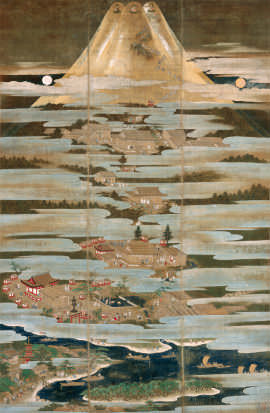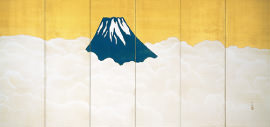Mt. Fuji's selection as a cultural World Heritage site
In June 2013, Mt. Fuji was added to the UNESCO World Heritage List as a cultural property.
This came as significant news, as it meant that the international community recognized the cultural sense of value of the Japanese people, for whom Mt. Fuji—a product of nature—has long been an object of faith and a source of artistic inspiration.
To our forebears, Fuji was a tall beautiful mountain and also one of horror and mystery for its eruptions and lava flows. The Japanese long believed volcanic activity was the act of god and revered Mt. Fuji as an object of worship from afar.
When eruptions subsided in the 12th century, Mt. Fuji became a center of ascetic training. Later, people came to climb its slopes for worship.
All the while, the beauty and grandeur of Mt. Fuji was a source of artistic inspiration. The greatest feature of Mt. Fuji is that it brought about coexistence between people and nature through the media of faith and art.
An object of faith and source of artistic inspiration—these invisible values led Mt. Fuji to World Heritage inscription.
Object of faith
Mt. Fuji and faith
Mt. Fuji was long revered as a sacred mountain not only for its exceptional beauty but also for its violent eruptions. In antiquity, the Japanese worshipped Mt. Fuji from afar, erecting the Asama Shrine at its foothills to pray for an easing of the eruptions.
When volcanic activity subsided in the late Heian period (794–1185), Mt. Fuji became a center of training in Shugendo, a fusion of traditional Japanese mountain worship and esoteric Buddhism. The practice of worshipping Mt. Fuji from afar thus changed and people came to climb its slopes for worship.
In the early 12th century, Matsudai Shonin founded Dainichi Temple at the summit. By the late Muromachi period (1336–1573), climbing Mt. Fuji for worship gradually gained currency and became a thing not only for monks but also for the general public.
In the Sengoku period (ca 1467–1590), Hasegawa Kakugyo developed a new sect of Mt. Fuji worship, which grew in popularity in the mid-Edo period (1603–1868) by the name Fuji-kou. This prompted many in the Kanto region to ascend Mt. Fuji on a pilgrimage of sacred sites such as the Shiraito Waterfall. In the Meiji period (1868–1912), women were permitted to climb to the summit. Countless people today aim for the summit in the hope of viewing the sunrise from the peak and circling the summit crater. For offering evidence of enduring faith in Mt. Fuji, the mountain trails, foothill areas, shrines, and lakes are registered as component sites of World Heritage inscription.

Fuji Mandala (color paint on silk)
Collection of Fujisan Hongu Sengen Taisha
Source of art
Mt. Fuji and art
The noble beauty of Mt. Fuji also long served as a source of artistic inspiration.
Manyoshu, the oldest extant anthology of Japanese poetry compiled some 1,200 years ago in the Nara period (710–794), contains poems depicting Mt. Fuji. The stunning peak also holds a place in classics such as The Tale of the Bamboo-Cutter and Tales of Ise as well as in haiku poems, Chinese poetry, and works of contemporary literature by the likes of Soseki Natsume and Osamu Dazai.
Mt. Fuji gained a presence in paintings in the Heian period (794–1185), the oldest surviving being Hata-no-Chitei’s Illustrated Biography of Prince Regent Shotoku. A growing number of artists took up Mt. Fuji as a subject in the Edo period (1603–1868), when climbing the slopes exploded in popularity thanks to Fuji-kou. Katsushika Hokusai’s 36 Views of Mount Fuji and Utagawa Hiroshige’s Thirty-six Views of Mount Fuji and Fifty-three Stations of the Tokaido depict Mt. Fuji from various angles. When these ukiyo-e paintings were exported, they had a great influence on Western artists like Vincent van Gogh and Claude Monet.
As such, Mt. Fuji made its way into the world by way of art. From the days of Manyoshu to the present, the Japanese have looked to Mt. Fuji for inspiration and encapsulated fleeting emotions in poems and paintings. Follow the history of Japanese culture and art, and it leads back to the grandeur of Mt. Fuji.

Taikan Yokoyama
Ultramarine Mt. Fuji
(right side of a pair of screens)
Collection of Shizuoka Prefectural Museum of Art